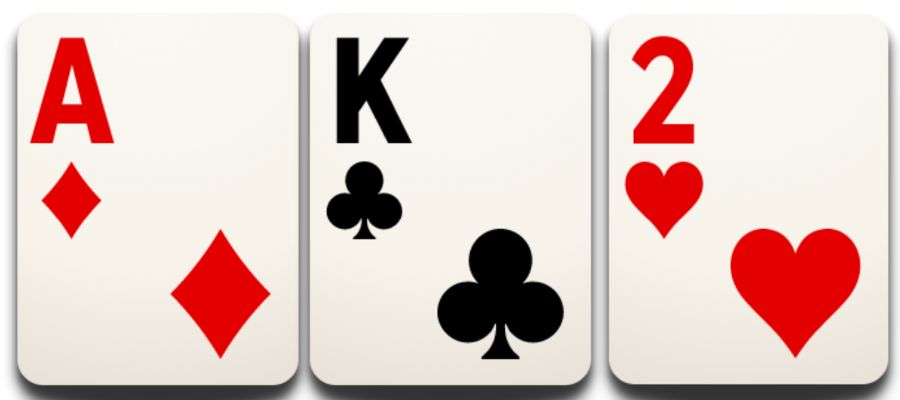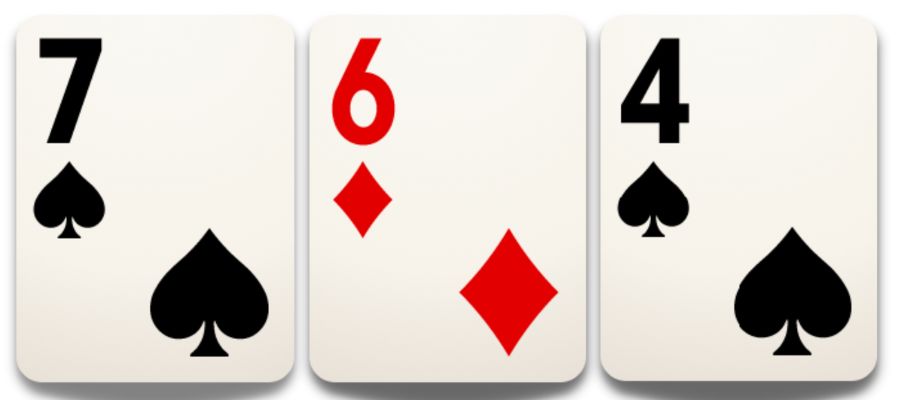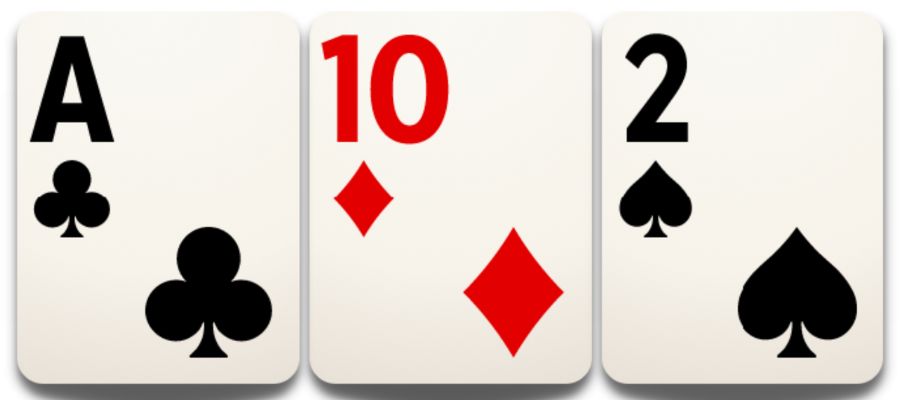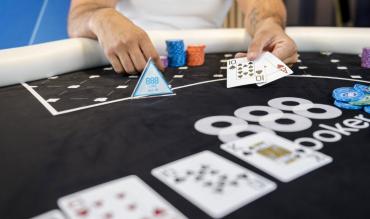The world of GTO poker can be confusing. This factor is especially true when it comes to bet sizing.
GTO solvers often use many different bet sizings at frequencies that might appear completely random. Making sense of what we see is challenging unless we know how to spot the underlying pattern.
In this article, we’ll aim to strip away the confusion and explain the mechanics behind GTO bet sizing.
Table of Contents
Nutted Equity – The Driving Force
A solid link exists between larger bet sizings and holding the nutted equity distribution.
The logical first question: what exactly is the nutted equity distribution?
We have the nutted equity distribution when we hold hands in our range that Villain can never beat. We can bet as large as we like with these hands, and there is relatively little our opponent can do about it.
River Example
Imagine the following river texture:

If Villain’s strongest hand is AQ, but we have two-pair and better in our range, we have the nutted equity distribution.
Now we can make large river bets with all our hands that can never be beaten. According to GTO, we should make a large bet with these hands, along with an appropriate number of bluffs.
But what happens if we change the scenario and give our opponent the nutted equity distribution?
- Imagine we are deciding whether to value bet AQ.
- But we know that Villain has stronger hands in his range.
We might think that we can no longer bet at all. But this reasoning isn’t always the case. It’s true that Villain now has the nutted equity distribution. But they may still hold several worse hands where we can extract value.
The key difference now is the bet sizing. When we had the nutted equity distribution in poker, we could bet as large as we liked without fear of reprisal.
Now, with the tables turned, large bet sizings are too risky. We could easily run into our opponent’s stronger hands and lose a large bet.
The correct approach is to use smaller bet sizings since we no longer hold the nutted equity.
Application to Flop Scenarios
The concept of nutted equity distribution applies to earlier street play, including the flop.
There is much we can learn by thinking about who has the nutted equity distribution.
- Large bet sizings will be incentivised if we have the nutted equity distribution.
- Small sizings will usually make more sense if our opponent has the nutted equity distribution.
Of course, this way of thinking about bet sizing is heavily simplified. There are more factors at work, one of which is balance (which we’ll discuss a little later).
But even a simplified understanding of GTO mechanics can go a long way.
Let’s see some examples@
Flop Example #1 – AK2r

In each example, we’ll imagine a BTN open raise and a BB cold call.
We go heads-up to the flop, and BB checks, giving us a continuation bet opportunity.
Our first texture is AK2 rainbow.
Take a moment and think. Who has the nutted equity distribution here?
There are specific hands we have in our range that BB can never beat, especially AA and KK. BB would 3bet these hands preflop if they had them.
Now it’s true that BB can have 22, A2s and K2s, but their next strongest holding after that is typically AJo. So, our AK, A2s, K2s and AQo combos do exceptionally well against our opponent’s range.
Although these hands can occasionally be beat, they are still strong enough for a large bet sizing to make sense.
We gave a GTO solver four sizes, and here are the results:
| Sizing | Frequency |
| 125% | 29.3% |
| 75% | 1.3% |
| 50% | 1% |
| 33% | 2.7% |
We see that the flop overbet sizing is an overwhelming favourite, no doubt due to our powerful nutted equity distribution.
Even in the modern game, only a few players realise it is theoretically correct to overbet the flop depending on the texture!
Watch the StreamTeam’s Nick “eastyyy22” Eastwood explain overbetting strategy:
Flop Example #2 – KQJ
Imagine the same scenario, but the board is now KQJ rainbow. Who has the nutted equity distribution this time?
- The nuts here is ATo / ATs.
- The second nuts is T9s / T9o.
Both players likely have these hands.
In other words, the nutted equity distribution is roughly a tie. When we don’t have the nutted equity distribution, we quickly lose our incentive to bet large.
Let’s see what the solver thinks:
| Sizing | Frequency |
| 125% | 0.3% |
| 75% | 4.6% |
| 50% | 15.8% |
| 33% | 25.7% |
As we can see, when we understand the pattern, the solver output looks much less random.
We may have an advantage on a KQJ rainbow board. But, generally, broadway cards on the flop are better for the preflop aggressor.
For example, we have hands like KK/QQ/JJ, which our opponent doesn’t have.
But our advantage now occurs deeper in the range than at the nutted equity. Players sometimes refer to this as a deep-range advantage. It signifies that our range is stronger overall. But we don’t have the nutted equity advantage.
The result is that the solver now prefers the 33% pot sizing.
However, it still recommends sizing up to 50%-pot quite frequently and even uses the 75%-sizing at a low frequency.
Flop Example #3 – 764ss

This last flop has been deliberately chosen to give BB the nutted equity advantage. It’s a 764 two-tone board.
We assume that BB has both 35s and 58s in their defending range. But they are not part of a standard opening range on the button.
BB has the nutted equity distribution in this case.
After the made straights, the next strongest holding is 77, which our opponent and we have in our ranges.
Analysis reveals that we still have a deep range advantage on this board, assuming standard GTO preflop ranges.
But we do not have the nutted equity distribution, which should impact the solver recommended bet sizings.
| Sizing | Frequency |
| 125% | 0% |
| 75% | 0.6% |
| 50% | 2.2% |
| 33% | 44.3% |
Once again, the solver prefers the 33% pot sizing. But we can see this time, it rarely recommends sizing up beyond 33% pot.
Flop Example #4 – AT2r
So far, we have deliberately chosen extreme examples to help illustrate the importance of nutted equity.
Many situations will be somewhere in the middle of the extremes outlined above.
For example, check out the solver-recommended sizings on the AT2 rainbow board:

| Sizing | Frequency |
| 125% | 0.3% |
| 75% | 4.6% |
| 50% | 15.8% |
| 33% | 25.7% |
We have the nutted equity advantage, so the solver uses the flop overbet sizing at a high frequency.
But we also see that the solver likes the 33% pot sizing.
Why does the solver like using 33% pot sizing despite having the nutted equity distribution?
It's helpful to remember that a range is still a collection of individual holdings. The overall range may have the nutted equity advantage. But, within that range are non-nut holdings, which are still strong enough to bet at a smaller sizing.
Whether non-nut holdings should bet relates to other variables such as their equity and vulnerability (likelihood of being outdrawn).
Balancing Sizing Ranges
In an ideal world, we’d bet all our very strong holdings for a large sizing and our weaker value hands for a small sizing.
But this strategy would allow our opponent to figure out that we never have a strong value hand when we bet small.
From a GTO perspective, we would describe such plays as unbalanced.
GTO play protects against this by shifting some of our strongest holdings into the smaller bet sizing range. We could also move some of our weaker value hands into the larger bet sizing range.
This strategy is not possible, though. Weaker value hands can’t play profitably with larger bet sizings.

All the hands in the large bet sizing range usually appear in the small bet sizing range with some frequency. But some weaker value hands only appear in a small bet sizing range (or checking range). They would be non-profitable if they bet large.
Whether we bet large or small, mixing in a few air hands as bluffs is necessary. This aspect applies to all bet sizings.
As a result, it’s common to mix the same air hand into all our bet sizing ranges (including checking).
GTO Bets Sizing Final Pointers
The result of the balancing process above is a mix of sizings that may appear random to the untrained eye. As we’ve seen, it is based on an extremely logical process.
Although it’s challenging for human players to reproduce GTO sizings perfectly, it’s not a requirement.
A basic understanding of the principles allows us to make good bet sizing decisions consistently.
Here is a quick recap of the simplified process discussed in this article:
- Look at the board and decide who has the nutted equity distribution.
- If we have the nutted equity distribution, we should use large bet sizings with our best hands and a selection of bluffs/semi-bluffs.
- Even if we have the nutted equity distribution, we should still consider using a smaller bet sizing range for our weaker value hands.
- We should stick to smaller bet sizings If our opponent has the nutted equity distribution.
- We can make use of smaller and medium sizings, but not large sizings if the nutted equity distribution is roughly even,
We want to avoid getting bogged down with precise solver output and individual combos.
Even having a basic idea about the mechanics of GTO bet sizing discussed in this article puts us ahead of 95% of players at the tables.
